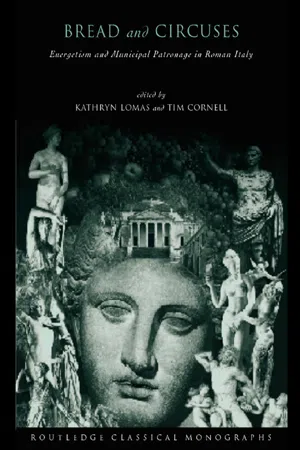Colosseum
The Colosseum is an ancient amphitheater located in Rome, Italy, and is one of the most iconic and well-preserved examples of Roman engineering and architecture. It was used for gladiatorial contests, public spectacles, and other events, showcasing advanced construction techniques and innovative design for its time. The Colosseum remains a symbol of ancient Roman civilization and continues to attract millions of visitors each year.
5 Key excerpts on "Colosseum"
- eBook - ePub
Gladiators
Violence and Spectacle in Ancient Rome
- Roger Dunkle(Author)
- 2013(Publication Date)
- Routledge(Publisher)
...Chapter 6 The Roman Amphitheatre and the Colosseum The amphitheatre As an architectural form, the Roman amphitheatre is one of the most influential buildings from antiquity. With its seating in the form of an ellipse surrounding an arena, it is the inspiration (with variations) for European and American football stadia. Perhaps the oldest surviving permanent stone structure for the presentation of gladiators is the amphitheatre at Pompeii (c. 70 BC) (Figure 26). 1 Other amphitheatres in Italy may be older but cannot be reliably dated. The following inscription reveals the details of its origin: C. Quinctius Valgus, son of C. [and] M. Porcius, son of M., fifth-year dual magistrates [duoviri quinquennales] were responsible for the building of this structure for public entertainment [spectacula] at their own expense in honour of the colony [i.e., Pompeii, which was a Roman colony] and gave the place in perpetuity to the colonists. 2 Valgus and Porcius were no doubt following the custom of thanking their fellow citizens for electing them to high office by giving a spectacle such as Figure 26 Amphitheatre at Pompeii. Vince Streano/Corbis gladiatorial combat and/or a venatio or, as in this case, erecting a public building. The impetus for building a permanent amphitheatre is connected with the fact that P. Sulla directed the foundation of Pompeii as a colony for his uncle’s veterans, who no doubt were enthusiastic about a site for the paramilitary violence of gladiatorial combat. 3 Note that the building is called a spectacula (literally, ‘seats for viewing a spectacle’); the Greek-derived word amphitheatrum (‘structure for viewing in the round’) was not used until the Augustan period. It is not freestanding like later amphitheatres. The arena was created by excavating earth, which was then heaped up as a support for the upper seating...
- eBook - ePub
'Bread and Circuses'
Euergetism and municipal patronage in Roman Italy
- Tim Cornell, Kathryn Lomas, Tim Cornell, Dr Kathryn Lomas, Kathryn Lomas(Authors)
- 2005(Publication Date)
- Routledge(Publisher)
...He not only rebuilt the Capitol, 12 but also built a temple of Peace, a sanctuary dedicated to Claudius, and of course, the Flavian amphitheatre, or Colosseum, which he began in AD70. Although this represents one of the most impressive building projects of the Roman empire, the amphitheatre was not merely a grandiose and extravagant gesture but a carefully calculated move. Nero had built himself a luxurious private residence, the Domus Aurea, across the heart of Rome; by draining the lake that was at the centre of Nero’s palace and building a venue for the populace, Vespasian was symbolically giving the area back to the people. 13 The Colosseum was the largest amphitheatre in the Roman world, and modern estimates have put the capacity in the region of 50,000 spectators. 14 If we accept that the population of Rome was around one million during the Flavian era, then only one in twenty would be able to attend a performance at any one time. Thus it can be assumed that tickets to events at the Colosseum were as difficult to get hold of as tickets to prestigious sports finals are now. Indeed, although the amphitheatre may have ostensibly been a gift to the people, it is likely that many never saw the inside; the building of such a huge imposing structure might well have been more about exclusion than inclusion. 15 Originally gladiatorial combats were held in the open and were available to all. This can be shown by Gaius Gracchus’ demand that temporary seats erected in the Forum in 123BC be torn down, as they were being rented out at prices which the poor of the city simply could not afford (Plut. C. Gracc. 12.3). Seats in the Colosseum would have been free originally, as it was important that the games were seen as a gift, rather than as a profit-making venture. Yet seats must have changed hands at extortionate prices, in much the same way as touts today still profit from the unofficial sale of tickets...
- eBook - ePub
- Roger B. Ulrich, Caroline K. Quenemoen, Roger B. Ulrich, Caroline K. Quenemoen(Authors)
- 2013(Publication Date)
- Wiley-Blackwell(Publisher)
...According to the dedicatory inscription, C. Quinctius Valgus and Marcus Porcius, duoviri of the new colony established at Pompeii in 80 BCE, paid for the structure with their own money and in accordance with their magistracies (CIL 10.852). The building was located just within the eastern city walls and measures 135 × 105 m externally. In common with other early amphitheaters, it was not provided with the extensive vaulted substructures, and the main support for the seating was formed by fill from digging out the sunken arena. The exterior retaining wall at the upper level was built of opus caementicium faced with opus incertum, strengthened by buttresses, and with staircases that provided spectator access to the top of the cavea. At the north and south ends were broad, sloping corridors leading down into the arena. The most famous, and most influential, of all amphitheaters in the Roman world was the Flavian Amphitheater in Rome, better known today as the Colosseum (Gabucci 2001; Lancaster 2005b; Welch 2007). It was begun by Vespasian on the site of the drained lake of Nero’s Domus Aurea and dedicated in 80 CE by Titus after his father’s death. This was a grand and monumental building of four stories, 52 m high, standing on elliptical concrete foundations 12 m deep. It was an astonishing feat of planning and engineering on an unprecedented scale. With outer dimensions of 188 × 156 m and an arena measuring 80 × 54 m, many provincial amphitheaters could each fit into the arena alone! An estimated 100,000 m 3 of travertine was used for the facade with 300 tons of iron to clamp the blocks together. An amazingly short construction time was made possible by the erection of a skeleton structure of travertine blocks that allowed many components to be worked on at the same time. A combination of materials was used: concrete, travertine, and tufa, which allowed architects to address the specific structural challenges inherent in its design (see Chapters 4 and 10)...
- eBook - ePub
Guildhall - City of London
History Guide Companion
- Graham Greenglass, Stephen Dinsdale(Authors)
- 2018(Publication Date)
- Pen & Sword History(Publisher)
...Chapter 12 The Roman Amphitheatre The remains of the amphitheatre are underneath the Art Gallery on the east side of Guildhall Yard. Roman remains are usually found about twenty feet under modern London. There is not a large amount left visible of the amphitheatre – just some remains of the East Gate, a small section of the lower parts of the wall, some of the drainage system, and sand which was used in the arena. Clever techniques incorporating lighting and luminescent effects have recreated the atmosphere of what the amphitheatre may have been like, including figures of combatants. The floor has stainless steel markings to show where the drains ran and there is a brass mark at the entrance to show where a large threshold made out of timber was found. On the surface of Guildhall Yard there is a ring of dark paving marking the line of where the amphitheatre walls would have been. The amphitheatre was elliptical and roughly the size of a modern football pitch. The Romans reputedly kept their citizens happy with bread and circuses and the amphitheatre was the setting for the circuses. The Colosseum in Rome was built under the Emperor Vespasian (AD 69-79) and other amphitheatres soon appeared throughout the Empire. The amphitheatres were built with public money but individuals, often emperors, staged the games to increase their own popularity. Everyone was allowed to go to the games, men and women, and admission was free. Roman Amphitheatre, Londinium. Amphitheatres were used, broadly speaking, for three types of activity: the execution and torture of criminals, prisoners of war and occasionally Christians; the hunting and baiting of animals; and gladiatorial combat – fights to the death between gladiators. In the Roman Colosseum games could go on for several days and thousands of animals and humans died. Amphitheatres were also sometimes used for religious purposes...
- eBook - ePub
Architecture in Motion
The history and development of portable building
- Robert Kronenburg(Author)
- 2013(Publication Date)
- Routledge(Publisher)
...3 ADAPTABLE BUILDING TECHNOLOGY BEFORE 1900 Two forces drive the architectural development of lightweight temporary structures: the functional requirement for such a building and the availability of suitable materials and skills from which to build it. Prior to the twentieth century, the limited presence of these factors reduced the development of significant buildings of this type to a few notable examples. In ancient times, building types that required large open spaces were restricted to those that were used for substantial gatherings of the populace. Even then, the necessity for a lightweight element (usually the roof) in the building was restricted as the early centres of civilisation were in temperate climates where environmental modification was a lesser priority. With the development of industrial techniques came not only the capability for larger spans but also the necessity in new building types and functions, and with the advent of the notion of beneficial technology, the ambition to use it to the fullest led to ambitious and innovative buildings which also had the purpose of portraying the achievements and power of their creators. AUDITORIA, THEATRES AND FESTIVALS Though the Greeks built special auditoria for performance, they were generally set in natural amphitheatres and their plays were so stylised as to require little in the way of demountable props or sets. The Roman amphitheatre was, however, a much more ambitious building creating an architectural type of its own, independent of geographical location. The Colosseum in Rome (built between AD 70 and 82) is a building of unique ambition in the ancient world, signifying a leap forward in engineering prowess as it consists of a superstructure rather than the ancient Greek theatres, which are earthbound spaces formed in the landscape. 1 The building could seat 50,000 spectators and was used for a wide variety of events including the well-known gladiatorial combats...




